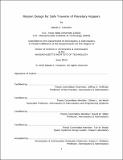Mission design for safe traverse of planetary hoppers
Author(s)
Cohanim, Babak, 1980-
DownloadFull printable version (3.812Mb)
Other Contributors
Massachusetts Institute of Technology. Department of Aeronautics and Astronautics.
Advisor
Jeffrey A. Hoffman.
Terms of use
Metadata
Show full item recordAbstract
Planetary hoppers are a new class of vehicle being developed that will provide planetary surface mobility by reusing the landing platform and its actuators to propulsively ascend, translate, and descend to new landing points on the surface of a planetary body. Hoppers enhance regional exploration, with the capability of rapid traverse over hundreds to thousands of meters, traverse over hazardous terrain, and exploration of cliffs and craters. These planetary mobility vehicles are fuel limited and as a result are enabled by carrying sensor payloads that require low mass, low volume, and low onboard computational resources. This thesis describes methods for hoppers to traverse and land safely in this constrained environment. The key questions of this research are: - What types of missions will hoppers perform and how does a hopper traverse as part of these missions? - How does a hopper traverse from its current location to a new landing site safely? This thesis: - describes various hopper mission scenarios and considerations for their mission designs. - creates an operational concept for safe landing for the traverse hop mission scenario. - develops a method that can be used to rapidly and safely detect landing areas at long ranges and low path angles. - develops a method to do fine detection of hazards once at the landing area.
Description
Thesis (Sc. D.)--Massachusetts Institute of Technology, Dept. of Aeronautics and Astronautics, 2013. This electronic version was submitted and approved by the author's academic department as part of an electronic thesis pilot project. The certified thesis is available in the Institute Archives and Special Collections. Cataloged from department-submitted PDF version of thesis. Includes bibliographical references (p. 116-125).
Date issued
2013Department
Massachusetts Institute of Technology. Department of Aeronautics and AstronauticsPublisher
Massachusetts Institute of Technology
Keywords
Aeronautics and Astronautics.